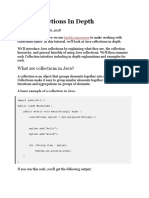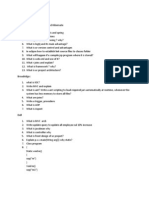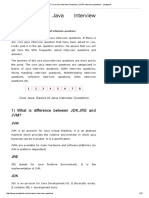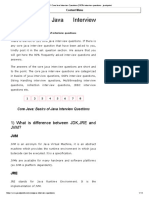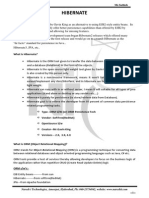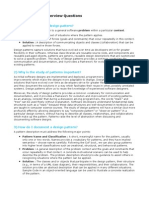Java Collections Interview Questions
Uploaded by
Ranga Rao KaranamJava Collections Interview Questions
Uploaded by
Ranga Rao KaranamJava
Interview Questions www.JavaInterview.in 1
Collections
Interfaces
We
will
discuss
about
different
collection
interfaces
along
with
their
purpose.
Refer
to
this
youtube
videos
(https://www.youtube.com/watch?v=GnR4hCvEIJQ
&
https://www.youtube.com/watch?v=6dKGpOKAQqs)
for
more
details.
Why do we need Collections in Java?
Arrays are not dynamic. Once an array of a particular size is declared, the size cannot be modified. To
add a new element to the array, a new array has to be created with bigger size and all the elements
from the old array copied to new array.
Collections are used in situations where data is dynamic. Collections allow adding an element, deleting
an element and host of other operations. There are a number of Collections in Java allowing to choose
the right Collection for the right context.
What
are
the
important
methods
that
are
declared
in
the
Collection
Interface?
Most
important
methods
declared
in
the
collection
interface
are
the
methods
to
add
and
remove
an
element.
add
method
allows
adding
an
element
to
a
collection
and
delete
method
allows
deleting
an
element
from
a
collection.
size()
methods
returns
number
of
elements
in
the
collection.
Other
important
methods
defined
as
part
of
collection
interface
are
shown
below.
interface
Collection<E>
extends
Iterable<E>
{
boolean
add(E
paramE);
boolean
remove(Object
paramObject);
int
size();
boolean
isEmpty();
void
clear();
boolean
contains(Object
paramObject);
boolean
containsAll(Collection<?>
paramCollection);
boolean
addAll(Collection<?
extends
E>
paramCollection);
boolean
removeAll(Collection<?>
paramCollection);
boolean
retainAll(Collection<?>
paramCollection);
Iterator<E>
iterator();
//A
NUMBER
OF
OTHER
METHODS
AS
WELL..
}
Can you explain briefly about the List Interface?
List interface extends Collection interface. So, it contains all methods defined in the Collection interface.
In addition, List interface allows operation specifying the position of the element in the Collection.
2 Java Interview Questions www.JavaInterview.in
Most important thing to remember about a List interface - any implementation of the List interface
would maintain the insertion order. When an element A is inserted into a List (without specifying
position) and then another element B is inserted, A is stored before B in the List.
When a new element is inserted without specifying a position, it is inserted at the end of the list of
elements.
However, We can also use the void add(int position, E paramE); method to insert an element at a
specific position.
Listed below are some of the important methods in the List interface (other than
those inherited from Collection interface):
interface List<E> extends Collection<E>
{
boolean addAll(int paramInt, Collection<? extends E> paramCollection);
E get(int paramInt);
E set(int paramInt, E paramE);
void add(int paramInt, E paramE);
E remove(int paramInt);
int indexOf(Object paramObject);
int lastIndexOf(Object paramObject);
ListIterator<E> listIterator();
ListIterator<E> listIterator(int paramInt);
List<E> subList(int paramInt1, int paramInt2);
}
Can you briefly explain about the Map Interface?
First and foremost, Map interface does not extend Collection interface. So, it does not inherit any of the
methods from the Collection interface.
A Map interface supports Collections that use a key value pair. A key-value pair is a set of linked data
items: a key, which is a unique identifier for some item of data, and the value, which is either the data or
a pointer to the data. Key-value pairs are used in lookup tables, hash tables and configuration files. A key
value pair in a Map interface is called an Entry.
Put method allows to add a key, value pair to the Map.
V put(K paramK, V paramV);
Get
method
allows
to
get
a
value
from
the
Map
based
on
the
key.
V
get(Object
paramObject);
Other important methods in Map Inteface are shown below:
interface Map<K, V>
{
Java Interview Questions www.JavaInterview.in 3
int size();
boolean isEmpty();
boolean containsKey(Object paramObject);
boolean containsValue(Object paramObject);
V get(Object paramObject);
V put(K paramK, V paramV);
V remove(Object paramObject);
void putAll(Map<? extends K, ? extends V> paramMap);
void clear();
Set<K> keySet();
Collection<V> values();
Set<Entry<K, V>> entrySet();
boolean equals(Object paramObject);
int hashCode();
public static abstract interface Entry<K, V>
{
K getKey();
V getValue();
V setValue(V paramV);
boolean equals(Object paramObject);
int hashCode();
}
}
What is the difference between Set and SortedSet?
SortedSet Interface extends the Set Interface. Both Set and SortedSet do not allow duplicate elements.
Main difference between Set and SortedSet is - an implementation of SortedSet interface maintains its
elements in a sorted order. Set interface does not guarantee any Order. For example, If elements 4,5,3
are inserted into an implementation of Set interface, it might store the elements in any order. However,
if we use SortedSet, the elements are sorted. The SortedSet implementation would give an output
3,4,5.
Important Operations in the SortedSet interface which are not present in the Set Interface are listed
below:
public interface SortedSet<E> extends Set<E> {
SortedSet<E> subSet(E fromElement, E toElement);
SortedSet<E> headSet(E toElement);
SortedSet<E> tailSet(E fromElement);
E first();
E last();
Comparator<? super E> comparator();
4 Java Interview Questions www.JavaInterview.in
}
Java Interview Questions www.JavaInterview.in
At http://www.JavaInterview.in, we want you to clear java interview with ease. So, in addition to
focussing on Core and Advanced Java we also focus on topics like Code Reviews, Performance,
Design Patterns, Spring and Struts.
We have created more than 20 videos to help you understand these topics and become an expert at
them. Visit our website http://www.JavaInterview.in for complete list of videos. Other than the
videos, we answer the top 200 frequently asked interview questions on our website.
With more 900K video views (Apr 2015), we are the most popular channel on Java Interview
Questions on YouTube.
Register here for more updates :
https://feedburner.google.com/fb/a/mailverify?uri=RithusTutorials
POPULAR
VIDEOS
Java
Interview
:
A
Freshers
Guide
-
Part
1:
https://www.youtube.com/watch?v=njZ48YVkei0
Java
Interview
:
A
Freshers
Guide
-
Part
2:
https://www.youtube.com/watch?v=xyXuo0y-xoU
Java
Interview
:
A
Guide
for
Experienced:
https://www.youtube.com/watch?v=0xcgzUdTO5M
Collections
Interview
Questions
1:
https://www.youtube.com/watch?v=GnR4hCvEIJQ
Collections
Interview
Questions
2:
https://www.youtube.com/watch?v=6dKGpOKAQqs
Collections
Interview
Questions
3:
https://www.youtube.com/watch?v=_JTIYhnLemA
Collections
Interview
Questions
4:
https://www.youtube.com/watch?v=ZNhT_Z8_q9s
Collections
Interview
Questions
5:
https://www.youtube.com/watch?v=W5c8uXi4qTw
What
is
difference
between
Map
and
SortedMap?
SortedMap
interface
extends
the
Map
interface.
In
addition,
an
implementation
of
SortedMap
interface
maintains
keys
in
a
sorted
order.
Methods
are
available
in
the
interface
to
get
a
ranges
of
values
based
on
their
keys.
public
interface
SortedMap<K,
V>
extends
Map<K,
V>
{
Comparator<?
super
K>
comparator();
SortedMap<K,
V>
subMap(K
fromKey,
K
toKey);
Java Interview Questions www.JavaInterview.in 5
SortedMap<K, V> headMap(K toKey);
SortedMap<K, V> tailMap(K fromKey);
K firstKey();
K lastKey();
}
Explain briefly about Queue Interface?
Queue Interface extends Collection interface. Queue Interface is typically used for implementation
holding elements in order for some processing.
Queue interface offers methods peek() and poll() which get the element at head of the queue. The
difference is that poll() method removes the head from queue also. peek() would keep head of the
queue unchanged.
interface Queue<E> extends Collection<E>
{
boolean offer(E paramE);
E remove();
E poll();
E element();
E peek();
}
Explain briefly about Iterator?
Iterator interface enables us to iterate (loop around) a collection. All collections define a method
iterator() that gets an iterator of the collection.
hasNext() checks if there is another element in the collection being iterated. next() gets the next
element.
public interface Iterator<E> {
boolean hasNext();
E next();
}
ArrayList
Refer
to
this
video
-
https://www.youtube.com/watch?v=_JTIYhnLemA
for
more
details
about
ArrayList.
Let
us
look
at
a
few
important
interview
questions.
Explain about ArrayList with an example?
ArrayList implements the list interface. So, ArrayList stores the elements in insertion order (by default).
Elements can be inserted into and removed from ArrayList based on their position.
Lets look at how to instantiate an ArrayList of integers.
6 Java Interview Questions www.JavaInterview.in
List<Integer> integers = new ArrayList<Integer>();
Code
like
below
is
permitted
because
of
auto
boxing.
5
is
auto
boxed
into
Integer
object
and
stored
in
ArrayList.
integers.add(5);//new
Integer(5)
Add method (by default) adds the element at the end of the list.
Can an ArrayList have Duplicate elements?
ArrayList can have duplicates (since List can have duplicates).
List<String> arraylist = new ArrayList<String>();
//adds at the end of list
arraylist.add("Sachin");//[Sachin]
//adds at the end of list
arraylist.add("Dravid");//[Sachin, Dravid]
//adds at the index 0
arraylist.add(0, "Ganguly");//[Ganguly, Sachin, Dravid]
//List allows duplicates - Sachin is present in the list twice
arraylist.add("Sachin");//[ Ganguly, Sachin, Dravid, Sachin]
System.out.println(arraylist.size());//4
System.out.println(arraylist.contains("Dravid"));//true
How do you iterate around an ArrayList using Iterator?
Example below shows how to iterate around an ArrayList.
Iterator<String> arraylistIterator = arraylist
.iterator();
while (arraylistIterator.hasNext()) {
String str = arraylistIterator.next();
System.out.println(str);//Prints the 4 names in the list on separate lines.
}
How do you sort an ArrayList?
Example below shows how to sort an ArrayList. It uses the Collections.sort method.
List<String> numbers = new ArrayList<String>();
numbers.add("one");
numbers.add("two");
numbers.add("three");
numbers.add("four");
System.out.println(numbers);//[one, two, three, four]
//Strings - By Default - are sorted alphabetically
Collections.sort(numbers);
Java Interview Questions www.JavaInterview.in 7
System.out.println(numbers);//[four, one, three, two]
How do you sort elements in an ArrayList using Comparable interface?
Consider the following class Cricketer.
class Cricketer implements Comparable<Cricketer> {
int runs;
String name;
public Cricketer(String name, int runs) {
super();
this.name = name;
this.runs = runs;
}
@Override
public String toString() {
return name + " " + runs;
}
@Override
public int compareTo(Cricketer that) {
if (this.runs > that.runs) {
return 1;
}
if (this.runs < that.runs) {
return -1;
}
return 0;
}
}
Lets now try to sort a list containing objects of Cricketer class.
List<Cricketer> cricketers = new ArrayList<Cricketer>();
cricketers.add(new Cricketer("Bradman", 9996));
cricketers.add(new Cricketer("Sachin", 14000));
cricketers.add(new Cricketer("Dravid", 12000));
cricketers.add(new Cricketer("Ponting", 11000));
System.out.println(cricketers);
//[Bradman 9996, Sachin 14000, Dravid 12000, Ponting 11000]
Now lets try to sort the cricketers.
Collections.sort(cricketers);
System.out.println(cricketers);
//[Bradman 9996, Ponting 11000, Dravid 12000, Sachin 14000]
How do you sort elements in an ArrayList using Comparator interface?
Other
option
to
sort
collections
is
by
creating
a
separate
class
which
implements
Comparator
interface.
Example
below:
8 Java Interview Questions www.JavaInterview.in
class DescendingSorter implements Comparator<Cricketer> {
//compareTo returns -1 if cricketer1 < cricketer2
// 1 if cricketer1 > cricketer2
// 0 if cricketer1 = cricketer2
//Since we want to sort in descending order,
//we should return -1 when runs are more
@Override
public int compare(Cricketer cricketer1,
Cricketer cricketer2) {
if (cricketer1.runs > cricketer2.runs) {
return -1;
}
if (cricketer1.runs < cricketer2.runs) {
return 1;
}
return 0;
}
}
Lets now try to sort the previous defined collection:
Collections
.sort(cricketers, new DescendingSorter());
System.out.println(cricketers);
//[Sachin 14000, Dravid 12000, Ponting 11000, Bradman 9996]
How do you convert List to Array?
There are two ways. First is to use toArray(String) function. Example below. This creates an array of
String's
List<String> numbers1 = new ArrayList<String>();
numbers1.add("one");
numbers1.add("two");
numbers1.add("three");
numbers1.add("four");
String[] numbers1Array = new String[numbers1.size()];
numbers1Array = numbers1.toArray(numbers1Array);
System.out.println(Arrays.toString(numbers1Array));
//prints [one, two, three, four]
Other
is
to
use
toArray()
function.
Example
below.
This
creates
an
array
of
Objects.
Object[]
numbers1ObjArray
=
numbers1.toArray();
System.out.println(Arrays
.toString(numbers1ObjArray));
//[one,
two,
three,
four]
How do you convert an Array to List?
String values[] = { "value1", "value2", "value3" };
Java Interview Questions www.JavaInterview.in 9
List<String> valuesList = Arrays.asList(values);
System.out.println(valuesList);//[value1, value2, value3]
Collections
Following
set
of
videos
deal
with
collections
interview
questions
in
great
detail
:
Video1,
Video2
&
Video3
What is Vector class? How is it different from an ArrayList?
Vector has the same operations as an ArrayList. However, all methods in Vector are synchronized. So,
we can use Vector if we share a list between two threads and we would want to them synchronized.
What is LinkedList? What interfaces does it implement? How is it different
from an ArrayList?
Linked List extends List and Queue.Other than operations exposed by the Queue interface, LinkedList
has the same operations as an ArrayList. However, the underlying implementation of Linked List is
different from that of an ArrayList.
ArrayList uses an Array kind of structure to store elements. So, inserting and deleting from an ArrayList
are expensive operations. However, search of an ArrayList is faster than LinkedList.
LinkedList uses a linked representation. Each object holds a link to the next element. Hence, insertion
and deletion are faster than ArrayList. But searching is slower.
Can
you
give
examples
of
classes
that
implement
the
Set
Interface?
HashSet,
LinkedHashSet
and
TreeSet
implement
the
Set
interface.
These
classes
are
described
in
great
detail
in
the
video
-
https://www.youtube.com/watch?v=W5c8uXi4qTw.
What
is
a
HashSet?
HashSet
implements
set
interface.
So,
HashSet
does
not
allow
duplicates.
However,
HashSet
does
not
support
ordering.
The
order
in
which
elements
are
inserted
is
not
maintained.
HashSet
Example
Set<String>
hashset
=
new
HashSet<String>();
hashset.add("Sachin");
System.out.println(hashset);//[Sachin]
hashset.add("Dravid");
System.out.println(hashset);//[Sachin,
Dravid]
Lets
try
to
add
Sachin
to
the
Set
now.
Sachin
is
Duplicate.
So
will
not
be
added.
returns
false.
hashset.add("Sachin");//returns
false
since
element
is
not
added
System.out.println(hashset);//[Sachin,
Dravid]
10 Java Interview Questions www.JavaInterview.in
What is a LinkedHashSet? How is different from a HashSet?
LinkedHashSet implements set interface and exposes similar operations to a HashSet. Difference is that
LinkedHashSet maintains insertion order. When we iterate a LinkedHashSet, we would get the elements
back in the order in which they were inserted.
What is a TreeSet? How is different from a HashSet?
TreeSet implements Set, SortedSet and NavigableSet interfaces.TreeSet is similar to HashSet except that
it stores elements in Sorted Order.
Set<String> treeSet = new TreeSet<String>();
treeSet.add("Sachin");
System.out.println(treeSet);//[Sachin]
Notice that the list is sorted after inserting Dravid.
//Alphabetical order
treeSet.add("Dravid");
System.out.println(treeSet);//[Dravid, Sachin]
Notice that the list is sorted after inserting Ganguly.
treeSet.add("Ganguly");
System.out.println(treeSet);//[Dravid, Ganguly, Sachin]
//Sachin is Duplicate. So will not be added. returns false.
treeSet.add("Sachin");//returns false since element is not added
System.out.println(treeSet);//[Dravid, Ganguly, Sachin]
Can you give examples of implementations of NavigableSet?
TreeSet implements this interface. Let's look at an example with TreeSet. Note that elements in TreeSet
are sorted.
TreeSet<Integer> numbersTreeSet = new TreeSet<Integer>();
numbersTreeSet.add(55);
numbersTreeSet.add(25);
numbersTreeSet.add(35);
numbersTreeSet.add(5);
numbersTreeSet.add(45);
NavigableSet interface has following methods.
Lower method finds the highest element lower than specified element. Floor method finds the highest
element lower than or equal to specified element. Corresponding methods for finding lowest number
higher than specified element are higher and ceiling. A few examples using the Set created earlier
below.
//Find the highest number which is lower than 25
System.out.println(numbersTreeSet.lower(25));//5
Java Interview Questions www.JavaInterview.in 1
1
//Find the highest number which is lower than or equal to 25
System.out.println(numbersTreeSet.floor(25));//25
//Find the lowest number higher than 25
System.out.println(numbersTreeSet.higher(25));//35
//Find the lowest number higher than or equal to 25
System.out.println(numbersTreeSet.ceiling(25));//25
What are the different implementations of a Map Interface?
HashMap and TreeMap. These classes are
https://www.youtube.com/watch?v=ZNhT_Z8_q9s.
explained
in
detail
in
this
video
What
is
a
HashMap?
HashMap
implements
Map
interface
there
by
supporting
key
value
pairs.
Lets
look
at
an
example.
HashMap
Example
Map<String,
Cricketer>
hashmap
=
new
HashMap<String,
Cricketer>();
hashmap.put("sachin",
new
Cricketer("Sachin",
14000));
hashmap.put("dravid",
new
Cricketer("Dravid",
12000));
hashmap.put("ponting",
new
Cricketer("Ponting",
11500));
hashmap.put("bradman",
new
Cricketer("Bradman",
9996));
What are the different methods in a Hash Map?
get method gets the value of the matching key.
System.out.println(hashmap.get("ponting"));//Ponting 11500
//if key is not found, returns null.
System.out.println(hashmap.get("lara"));//null
If
existing
key
is
reused,
it
would
replace
existing
value
with
the
new
value
passed
in.
//In
the
example
below,
an
entry
with
key
"ponting"
is
already
present.
//Runs
are
updated
to
11800.
hashmap.put("ponting",
new
Cricketer("Ponting",
11800));
//gets
the
recently
updated
value
System.out.println(hashmap.get("ponting"));//Ponting
11800
What is a TreeMap? How is different from a HashMap?
TreeMap is similar to HashMap except that it stores keys in sorted order. It implements NavigableMap
interface and SortedMap interfaces along with the Map interface.
Map<String, Cricketer> treemap = new TreeMap<String, Cricketer>();
treemap.put("sachin",
new Cricketer("Sachin", 14000));
12 Java Interview Questions www.JavaInterview.in
System.out.println(treemap);
//{sachin=Sachin 14000}
We
will
now
insert
a
Cricketer
with
key
dravid.
In
sorted
order,dravid
comes
before
sachin.
So,
the
value
with
key
dravid
is
inserted
at
the
start
of
the
Map.
treemap.put("dravid",
new
Cricketer("Dravid",
12000));
System.out.println(treemap);
//{dravid=Dravid
12000,
sachin=Sachin
14000}
We
will
now
insert
a
Cricketer
with
key
ponting.
In
sorted
order,
ponting
fits
in
between
dravid
and
sachin.
treemap.put("ponting",
new
Cricketer("Ponting",
11500));
System.out.println(treemap);
//{dravid=Dravid
12000,
ponting=Ponting
11500,
sachin=Sachin
14000}
treemap.put("bradman",
new
Cricketer("Bradman",
9996));
System.out.println(treemap);
//{bradman=Bradman
9996,
dravid=Dravid
12000,
ponting=Ponting
11500,
sachin=Sachin
14000}
Can you give an example of implementation of NavigableMap Interface?
TreeMap is a good example of a NavigableMap interface implementation. Note that keys in TreeMap are
sorted.
TreeMap<Integer, Cricketer> numbersTreeMap = new TreeMap<Integer, Cricketer>();
numbersTreeMap.put(55, new Cricketer("Sachin",
14000));
numbersTreeMap.put(25, new Cricketer("Dravid",
12000));
numbersTreeMap.put(35, new Cricketer("Ponting",
12000));
numbersTreeMap.put(5,
new Cricketer("Bradman", 9996));
numbersTreeMap
.put(45, new Cricketer("Lara", 10000));
lowerKey
method
finds
the
highest
key
lower
than
specified
key.
floorKey
method
finds
the
highest
key
lower
than
or
equal
to
specified
key.
Corresponding
methods
for
finding
lowest
key
higher
than
specified
key
are
higher
and
ceiling.
A
few
examples
using
the
Map
created
earlier
below.
//Find
the
highest
key
which
is
lower
than
25
System.out.println(numbersTreeMap.lowerKey(25));//5
//Find
the
highest
key
which
is
lower
than
or
equal
to
25
System.out.println(numbersTreeMap.floorKey(25));//25
//Find
the
lowest
key
higher
than
25
Java Interview Questions www.JavaInterview.in 1
3
System.out.println(numbersTreeMap.higherKey(25));//35
//Find
the
lowest
key
higher
than
or
equal
to
25
System.out.println(numbersTreeMap.ceilingKey(25));//25
What
is
a
PriorityQueue?
PriorityQueue
implements
the
Queue
interface.
//Using
default
constructor
-
uses
natural
ordering
of
numbers
//Smaller
numbers
have
higher
priority
PriorityQueue<Integer>
priorityQueue
=
new
PriorityQueue<Integer>();
Adding an element into priority queue - offer method
priorityQueue.offer(24);
priorityQueue.offer(15);
priorityQueue.offer(9);
priorityQueue.offer(45);
System.out.println(priorityQueue);//[9, 24, 15, 45]
Peek method examples
//peek method get the element with highest priority.
System.out.println(priorityQueue.peek());//9
//peek method does not change the queue
System.out.println(priorityQueue);//[9, 24, 15, 45]
//poll method gets the element with highest priority.
System.out.println(priorityQueue.poll());//9
//peek method removes the highest priority element from the queue.
System.out.println(priorityQueue);//[24, 15, 45]
//This comparator gives high priority to the biggest number.
Comparator reverseComparator = new Comparator<Integer>() {
public int compare(Integer paramT1,
Integer paramT2) {
return paramT2 - paramT1;
}
};
What are the static methods present in the Collections class?
static int binarySearch(List, key)
o Can be used only on sorted list
static int binarySearch(List, key, Comparator)
static void reverse(List)
o Reverse the order of elements in a List.
static Comparator reverseOrder();
o Return a Comparator that sorts the reverse of the collection current sort sequence.
static void sort(List)
static void sort(List, Comparator)
14 Java Interview Questions www.JavaInterview.in
Videos
We
have
created
more
than
20
videos
to
help
you
understand
these
topics
and
become
an
expert
at
them.
You
can
watch
these
videos
for
free
on
YouTube.
Visit
our
website
http://www.JavaInterview.in
for
complete
list
of
videos.
We
answer
the
top
200
frequently
asked
interview
questions
on
the
website.
Register
here
for
more
updates
:
https://feedburner.google.com/fb/a/mailverify?uri=RithusTutorials
Java
Interview
:
A
Freshers
Guide
-
Part
1:
https://www.youtube.com/watch?v=njZ48YVkei0
Java
Interview
:
A
Freshers
Guide
-
Part
2:
https://www.youtube.com/watch?v=xyXuo0y-xoU
Java
Interview
:
A
Guide
for
Experienced:
https://www.youtube.com/watch?v=0xcgzUdTO5M
Collections
Interview
Questions
1:
https://www.youtube.com/watch?v=GnR4hCvEIJQ
Collections
Interview
Questions
2:
https://www.youtube.com/watch?v=6dKGpOKAQqs
Collections
Interview
Questions
3:
https://www.youtube.com/watch?v=_JTIYhnLemA
Collections
Interview
Questions
4:
https://www.youtube.com/watch?v=ZNhT_Z8_q9s
Collections
Interview
Questions
5:
https://www.youtube.com/watch?v=W5c8uXi4qTw
You might also like
- Download full Data Structures the Fun Way: An Amusing Adventure with Coffee-Filled Examples 1st Edition Jeremy Kubica ebook all chapters100% (6)Download full Data Structures the Fun Way: An Amusing Adventure with Coffee-Filled Examples 1st Edition Jeremy Kubica ebook all chapters65 pages
- Spring Boot Interview Questions: Click HereNo ratings yetSpring Boot Interview Questions: Click Here15 pages
- Java Performance Optimization Tips & Interview QuestionsNo ratings yetJava Performance Optimization Tips & Interview Questions12 pages
- Java Multithreading Interview Questions And AnswersFrom EverandJava Multithreading Interview Questions And AnswersNo ratings yet
- Data Structures and Algorithms Geeksforgeeks Summer Training ReportNo ratings yetData Structures and Algorithms Geeksforgeeks Summer Training Report16 pages
- Quick Reference Before Appearing For Java InterviewNo ratings yetQuick Reference Before Appearing For Java Interview8 pages
- 100+ Java Interview Questions You Must Prepare in 2019: Mymock Interview Service For Real Tech JobsNo ratings yet100+ Java Interview Questions You Must Prepare in 2019: Mymock Interview Service For Real Tech Jobs20 pages
- Spring IOC DAO Modules by Sekhar Sir JavabynataraJ100% (3)Spring IOC DAO Modules by Sekhar Sir JavabynataraJ260 pages
- 500 Question Asked in Core Java InterviewNo ratings yet500 Question Asked in Core Java Interview118 pages
- Mastering Concurrency Programming Java 8 Ebook B012o8s89k PDFNo ratings yetMastering Concurrency Programming Java 8 Ebook B012o8s89k PDF5 pages
- 201 Core Java Interview Questions - OOPs Interview Questions - Javatpoint0% (1)201 Core Java Interview Questions - OOPs Interview Questions - Javatpoint12 pages
- Hibernate Interview Questions and Answers: 1.what Is ORM ?No ratings yetHibernate Interview Questions and Answers: 1.what Is ORM ?34 pages
- Java String Interview Questions and Answers - JournalDevNo ratings yetJava String Interview Questions and Answers - JournalDev51 pages
- Spring Boot Interview Questions: 10 Step Reference CoursesNo ratings yetSpring Boot Interview Questions: 10 Step Reference Courses18 pages
- Spring Boot Annotations: Top 30+ Most Used Spring AnnotationsNo ratings yetSpring Boot Annotations: Top 30+ Most Used Spring Annotations11 pages
- 201 Core Java Interview Questions - OOPs Interview Questions0% (1)201 Core Java Interview Questions - OOPs Interview Questions13 pages
- Core Java Interview Questions and AnswersNo ratings yetCore Java Interview Questions and Answers10 pages
- Sathish Sir Hibernate Notes Naresh I Technologies93% (14)Sathish Sir Hibernate Notes Naresh I Technologies215 pages
- Interview Questions: Etiam Sit Amet EstNo ratings yetInterview Questions: Etiam Sit Amet Est29 pages
- Java Core Interview in Australia. Questions and Answers. Tech interviewer’s notesFrom EverandJava Core Interview in Australia. Questions and Answers. Tech interviewer’s notesNo ratings yet
- Java/J2EE Design Patterns Interview Questions You'll Most Likely Be Asked: Second EditionFrom EverandJava/J2EE Design Patterns Interview Questions You'll Most Likely Be Asked: Second EditionNo ratings yet
- Core Java: Made Simple: A popular language for Android smart phone application, favoured for edge device andFrom EverandCore Java: Made Simple: A popular language for Android smart phone application, favoured for edge device andNo ratings yet
- Core Java Interview Questions You'll Most Likely Be Asked: Job Interview Questions SeriesFrom EverandCore Java Interview Questions You'll Most Likely Be Asked: Job Interview Questions Series4/5 (14)
- Spring and Spring Boot Interview Questions and Answers. Tech interviewer’s notesFrom EverandSpring and Spring Boot Interview Questions and Answers. Tech interviewer’s notes5/5 (3)
- RESTful Java Web Services Interview Questions You'll Most Likely Be Asked: Second EditionFrom EverandRESTful Java Web Services Interview Questions You'll Most Likely Be Asked: Second EditionNo ratings yet
- 300 Embedded Programming Problems by Yashwanth Naidu TNo ratings yet300 Embedded Programming Problems by Yashwanth Naidu T85 pages
- Laboratory Manual: Government Engineering College, ModasaNo ratings yetLaboratory Manual: Government Engineering College, Modasa72 pages
- Heuristic Search Strategies: Informed (Heuris7c) Search StrategyNo ratings yetHeuristic Search Strategies: Informed (Heuris7c) Search Strategy12 pages
- Data Structures Question Bank - PreparatoryNo ratings yetData Structures Question Bank - Preparatory1 page
- CS 1538 Introduction To Simulation: Course Notes ForNo ratings yetCS 1538 Introduction To Simulation: Course Notes For228 pages
- Analysis of Algorithms: Chapter 9.1, 9.2, 9.3, 9.4No ratings yetAnalysis of Algorithms: Chapter 9.1, 9.2, 9.3, 9.452 pages
- Download full Data Structures the Fun Way: An Amusing Adventure with Coffee-Filled Examples 1st Edition Jeremy Kubica ebook all chaptersDownload full Data Structures the Fun Way: An Amusing Adventure with Coffee-Filled Examples 1st Edition Jeremy Kubica ebook all chapters
- Java Performance Optimization Tips & Interview QuestionsJava Performance Optimization Tips & Interview Questions
- Java Multithreading Interview Questions And AnswersFrom EverandJava Multithreading Interview Questions And Answers
- Data Structures and Algorithms Geeksforgeeks Summer Training ReportData Structures and Algorithms Geeksforgeeks Summer Training Report
- Quick Reference Before Appearing For Java InterviewQuick Reference Before Appearing For Java Interview
- 100+ Java Interview Questions You Must Prepare in 2019: Mymock Interview Service For Real Tech Jobs100+ Java Interview Questions You Must Prepare in 2019: Mymock Interview Service For Real Tech Jobs
- Spring IOC DAO Modules by Sekhar Sir JavabynataraJSpring IOC DAO Modules by Sekhar Sir JavabynataraJ
- Mastering Concurrency Programming Java 8 Ebook B012o8s89k PDFMastering Concurrency Programming Java 8 Ebook B012o8s89k PDF
- 201 Core Java Interview Questions - OOPs Interview Questions - Javatpoint201 Core Java Interview Questions - OOPs Interview Questions - Javatpoint
- Hibernate Interview Questions and Answers: 1.what Is ORM ?Hibernate Interview Questions and Answers: 1.what Is ORM ?
- Java String Interview Questions and Answers - JournalDevJava String Interview Questions and Answers - JournalDev
- Spring Boot Interview Questions: 10 Step Reference CoursesSpring Boot Interview Questions: 10 Step Reference Courses
- Spring Boot Annotations: Top 30+ Most Used Spring AnnotationsSpring Boot Annotations: Top 30+ Most Used Spring Annotations
- 201 Core Java Interview Questions - OOPs Interview Questions201 Core Java Interview Questions - OOPs Interview Questions
- Java Core Interview in Australia. Questions and Answers. Tech interviewer’s notesFrom EverandJava Core Interview in Australia. Questions and Answers. Tech interviewer’s notes
- Java/J2EE Design Patterns Interview Questions You'll Most Likely Be Asked: Second EditionFrom EverandJava/J2EE Design Patterns Interview Questions You'll Most Likely Be Asked: Second Edition
- Core Java: Made Simple: A popular language for Android smart phone application, favoured for edge device andFrom EverandCore Java: Made Simple: A popular language for Android smart phone application, favoured for edge device and
- Core Java Interview Questions You'll Most Likely Be Asked: Job Interview Questions SeriesFrom EverandCore Java Interview Questions You'll Most Likely Be Asked: Job Interview Questions Series
- Spring and Spring Boot Interview Questions and Answers. Tech interviewer’s notesFrom EverandSpring and Spring Boot Interview Questions and Answers. Tech interviewer’s notes
- RESTful Java Web Services Interview Questions You'll Most Likely Be Asked: Second EditionFrom EverandRESTful Java Web Services Interview Questions You'll Most Likely Be Asked: Second Edition
- 300 Embedded Programming Problems by Yashwanth Naidu T300 Embedded Programming Problems by Yashwanth Naidu T
- Laboratory Manual: Government Engineering College, ModasaLaboratory Manual: Government Engineering College, Modasa
- Heuristic Search Strategies: Informed (Heuris7c) Search StrategyHeuristic Search Strategies: Informed (Heuris7c) Search Strategy
- CS 1538 Introduction To Simulation: Course Notes ForCS 1538 Introduction To Simulation: Course Notes For
- Analysis of Algorithms: Chapter 9.1, 9.2, 9.3, 9.4Analysis of Algorithms: Chapter 9.1, 9.2, 9.3, 9.4



















